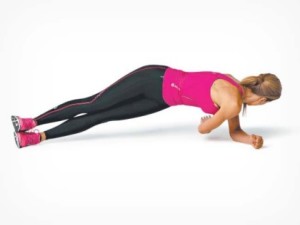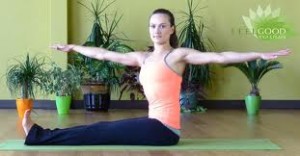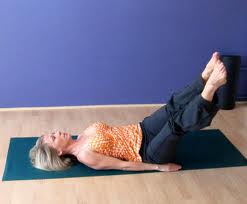Pilates
See Active Blog Page for Pilates Workout Video
Pilates is a body conditioning routine that may help build flexibility, muscle strength, and endurance in the legs, abdominals, arms, hips, and back. It puts emphasis on spinal and pelvic alignment, breathing, and developing a strong core or center, and improving coordination and balance. Pilates’ system allows for different exercises to be modified in range of difficulty from beginning to advanced. Intensity can be increased over time as the body conditions and adapts to the exercises. Unlike some forms of exercise, Pilates does not over-develop some parts of the body and neglect others. While Pilates training focuses on core strength, it trains the body as an integrated whole. Pilates workouts promote strength and balanced muscle development as well as flexibility and increased range of motion for the joints
Pelvic Curl
The Pelvic Curl is a foundation exercise with a myriad of benefits. It mobilizes the spine and prepares it for exercise as well as teaches correct recruitment of the internal support system. The pelvic curl develops body awareness and brings focus to the powerhouse. This exercise promotes mobility in the pelvic region, releasing both physical and mental tension in the process.
Step 1: Set Up
Inhale. Lie supine (on your back), in a neutral spine position, keeping the entire body relaxed. Bend the knees and place the feet hip width apart. Sense the elongation through the spine while gliding the scapula down the back, placing the arms straight by the sides with the fingers reaching toward the feet. Make sure the neck is relaxed with the chin tilted slightly to the chest.
Step 2: Movement
Exhale. Draw in the abdominal muscles. Begin to curl the pelvis, lifting the lower back vertebra by vertebra off the floor. Midway through the motion, recruit the hamstrings to lift the pelvis and trunk higher off the mat.
Than as you inhale, keep the body still, with the legs parallel. Engage the shoulder extensors to accentuate the extension of the upper back.
Exhale. Articulate the spine in reverse order from the top of the spine, vertebra by vertebra, accentuating the flexion through the lumbar region. Return to the starting position.
Step 3: Imagery
Deliberate and careful peeling of a banana off of the fruit
Imprint the spine, into the sand, at the beach.
Step 4: Muscle Focus
Abdominal Muscles, Hamstrings
Step 5: Objectives
Improve spinal articulation
Establish pelvic lumbar stabilization
Develop abdominal and hamstring control, and lengthen hip flexors.
The Single Straight Leg Stretch
The Single Straight Leg Stretch is a Pilates mat exercise that builds endurance and strengthens the abdominal muscles. It also stretches the backs of the legs.
1.Begin lying on the floor with your legs extended straight out in front of you. Rest your arms along your sides with your palms facing down. Relax your shoulders away from your ears and let your belly drop toward the floor.
2. Inhale as you pull your abs in deeply, sinking your navel in toward your spine. Curl your head forward until your chin touches your chest as you simultaneously bend both of your knees and pull both legs in toward your chest. Point your toes and clasp your hands around your shins.
3. Extend your right leg straight up to the ceiling. Hold onto your right ankle with both hands. Extend your left leg in front of you, fully straightening the leg. Let your left heel hover about two inches above the mat.
4. Keep your abdominal muscles scooped, your back flat, and your upper body curved throughout the movements.
5. Inhale and press your spine deeply into the mat. Exhale as you pull your right leg closer toward your head with two short pulses.
6. Exhale twice, once with each pulse.
Inhale again and on your exhalation, quickly switch the position of your legs by “scissoring” them past each other.
7. Hold onto your left ankle and repeat the movement. Inhale as you press your spine and exhale as you pull your leg close with two short pulses.
8. Repeat five times with each leg. More advanced students can repeat up to 12 times with each leg. When you are finished with the sets, clasp your hands behind your head and bring both legs together. Bend your knees so your legs form 90-degree angles to prepare yourself for the
Double Leg Stretch
1. Lying flat on your mat, tighten your abs and keep your spine in neutral. Bring your knees up toward your chest, holding your lower legs parallel to the floor, and place your hands on your knees.
2. Inhale and straighten your legs and arms parallel to each other at a 45-degree angle to the floor. Raise your head and shoulders off the mat so your chin is parallel to your arms and legs as well.
3. Keep your legs in the same position.
4. Now you’ll make a large continuous circle with your arms. Start by reaching behind your head with your arms straightened. Then pull your arms around to your sides, making a complete circle as they come back to the 45-degree position parallel to your legs, and then back to your knees.
5. Repeat this movement 10 times.
Side bridge twists
Why? Side bridge twists work the core and obliques to help tone your abs.
it also works both your rectus (6pack) and transverse (horizontal belt) abs, internal and external obliques (sides) and erector spinae (low back). You’ll find rather quickly that this exercise utilizes stabilizing muscles in your core, shoulders and lower body to help you balance! It may look easy, but don’t underestimate its difficulty; the goal is to maintain proper form and go through the movement slowly, so don’t worry about how many reps you can do.
Set-up:
- Start in plank pose on your toes.
Variation-knee plank. *Your range of motion will be limited because your knee will brush the mat.
Exercise:
- Maintaining balance-lift right hand and left leg off of the floor; bend elbow and knee while twisting.
- Hold for 1-2 seconds, return to the center and repeat with left hand and right leg= 1 rep.
The wider you place toes in a plank position-the easier the exercise becomes! Greater base of stability=more balance. Try this technique will this exercise and as you get stronger and your balance improves, bring your toes closer together.
Spin Twist
1. Begin seated at the top of your mat with your legs extended in front of you and your hands resting at your sides. Sit up as tall as possible, pressing your weight evenly across both sit bones.
2. Press your legs together firmly and reach strongly through your heels. Flex your feet and spread your toes.
3. Pull your navel in toward your spine, strongly engaging your abdominal muscles.
4. Raise your arms out to the sides at shoulder-height. Keeping your palms facing down, extend outward through your fingertips. Pull your shoulder blades together and keep your chin level (neither raised nor tucked).
5. On an inhalation, pull your navel in toward your spine and lift it up. Imagine you are lengthening your entire torso and spine up to the ceiling through the crown of your head.
6. Initiating the movement from your torso, twist to the right as far as possible. Do not let your left hip lift off the floor. Engage your buttocks and keep your legs pressing firmly together.
7. Inhale deeply as you twist your torso back to center, keeping your arms extended.
8. Now twist to the left. Exhale fully and twist as far you can. Then inhale and twist back to center.
9. Complete three full rounds, twisting farther and exhaling more fully with each repetition. End by returning to center and lowering your arms to your sides.
Corkscrew
1. Begin lying on the floor with your legs extended straight out in front of you. Rest your arms along your sides with your palms facing down. Relax your shoulders away from your ears and let your belly drop toward the floor.
2. Press your upper thighs and knees together and raise both legs straight up to the ceiling. Point your toes and turn your legs slightly outward in the Pilates stance.
3. Sink your navel in toward your spine. Your back should be imprinted, not in neutral spine position.
4. On an inhalation, circle your legs to the left and then down. Exhale as you bring your legs around to the right and back up to their starting position. Keep your hips and shoulders on the mat as you circle your legs, and keep your legs pressing together throughout the entire movement.
5. When your legs get back to their starting position, reverse the direction of the circle, inhaling as you drop your legs to the right and down. Then exhale as you bring your legs to the left and up. This is one complete set.
6. Do up to five complete sets. End by hugging your knees into your chest while lying on your back
Teaser
Starting Position for the Teaser:
Start balanced on your tailbone with legs extended and arms reaching towards your feet. Chest is high with your shoulders down and the back of your neck is long.
Movement:
1. Inhale hold your balance to prepare.
2. Exhale as you articulate the spine down down the mat. Reach your waistband to the mat while your legs simultaneously lower as you bring the rest of the spine, shoulders, and then head down.
3. Stretch your arms over-head on the mat with legs long. Inhale as you stretch then exhale to circle the arms out curling the head and shoulders while simultaneously peeling the spine and legs back up into the Teaser or “V” position.
4. Repeat this Pilates exercise for 6-8 repetitions.






